BUS3002 - Strategy Process and Context in Strategic Management
VerifiedAdded on 2023/05/28
|10
|2471
|426
Essay
AI Summary
This essay critically evaluates the importance of strategy process and strategy context in determining strategy content within organizations. It addresses key issues in strategic management, including stakeholder engagement, resource leveraging, and competitive response, while also considering internal factors like board operations and quality management. The essay explores current trends shaping future strategic decision-making, such as employee empowerment and technological advancements, using examples like Tommy Hilfiger's collaboration with IBM on AI-driven fashion trends. It emphasizes the importance of a clear strategic vision, core values, and performance indicators, as well as the alignment of strategy formulation and implementation through accountability and resource allocation. The essay identifies common reasons for implementation failure, such as lack of ownership and poor communication, and uses case studies like Facebook's management structure to illustrate successful strategies. The essay concludes by highlighting the need for organizations to bridge the gap between theoretical knowledge and practical application in strategic management.
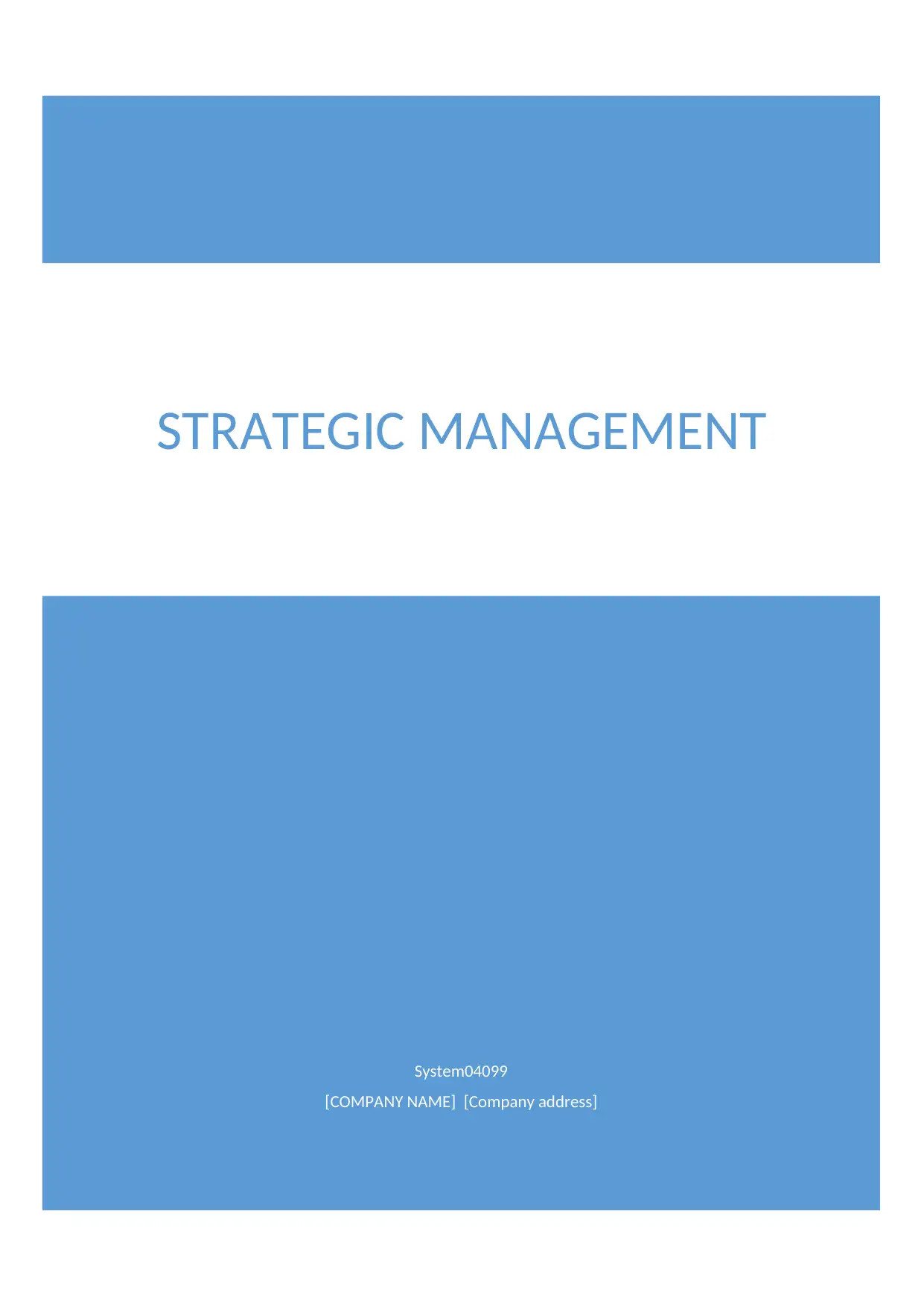
System04099
[COMPANY NAME] [Company address]
STRATEGIC MANAGEMENT
[COMPANY NAME] [Company address]
STRATEGIC MANAGEMENT
Paraphrase This Document
Need a fresh take? Get an instant paraphrase of this document with our AI Paraphraser
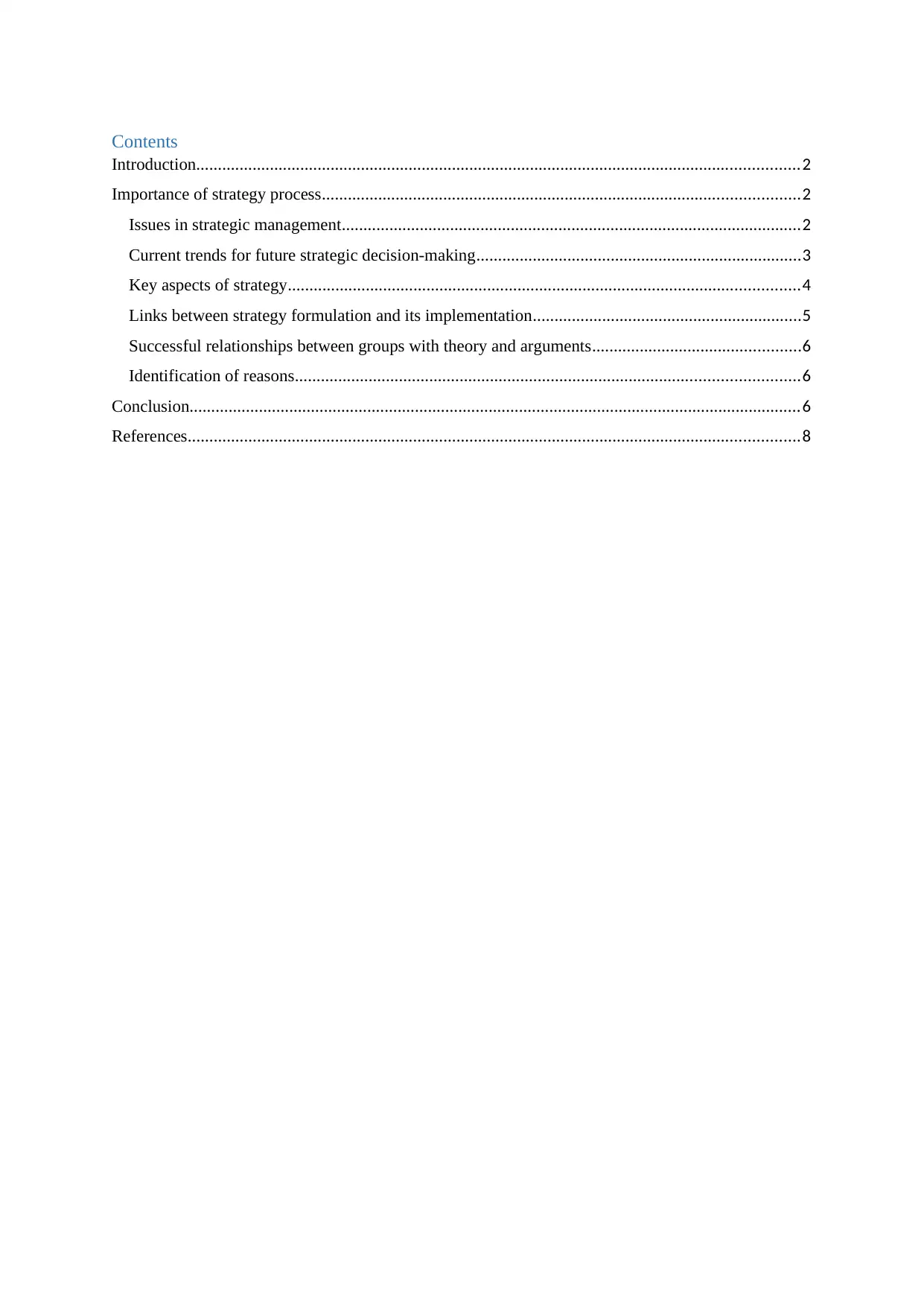
Contents
Introduction...........................................................................................................................................2
Importance of strategy process..............................................................................................................2
Issues in strategic management..........................................................................................................2
Current trends for future strategic decision-making...........................................................................3
Key aspects of strategy......................................................................................................................4
Links between strategy formulation and its implementation..............................................................5
Successful relationships between groups with theory and arguments................................................6
Identification of reasons....................................................................................................................6
Conclusion.............................................................................................................................................6
References.............................................................................................................................................8
Introduction...........................................................................................................................................2
Importance of strategy process..............................................................................................................2
Issues in strategic management..........................................................................................................2
Current trends for future strategic decision-making...........................................................................3
Key aspects of strategy......................................................................................................................4
Links between strategy formulation and its implementation..............................................................5
Successful relationships between groups with theory and arguments................................................6
Identification of reasons....................................................................................................................6
Conclusion.............................................................................................................................................6
References.............................................................................................................................................8
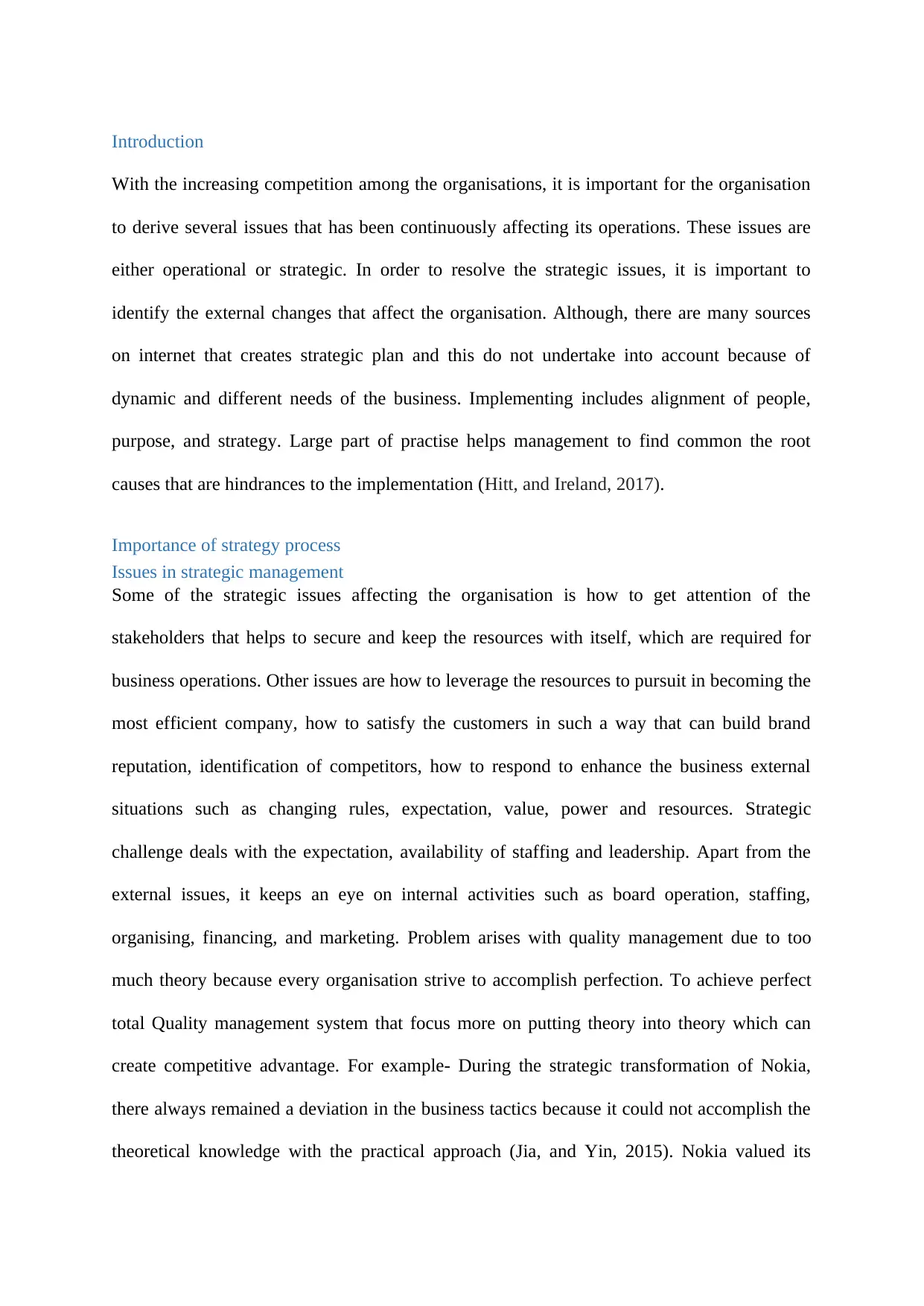
Introduction
With the increasing competition among the organisations, it is important for the organisation
to derive several issues that has been continuously affecting its operations. These issues are
either operational or strategic. In order to resolve the strategic issues, it is important to
identify the external changes that affect the organisation. Although, there are many sources
on internet that creates strategic plan and this do not undertake into account because of
dynamic and different needs of the business. Implementing includes alignment of people,
purpose, and strategy. Large part of practise helps management to find common the root
causes that are hindrances to the implementation (Hitt, and Ireland, 2017).
Importance of strategy process
Issues in strategic management
Some of the strategic issues affecting the organisation is how to get attention of the
stakeholders that helps to secure and keep the resources with itself, which are required for
business operations. Other issues are how to leverage the resources to pursuit in becoming the
most efficient company, how to satisfy the customers in such a way that can build brand
reputation, identification of competitors, how to respond to enhance the business external
situations such as changing rules, expectation, value, power and resources. Strategic
challenge deals with the expectation, availability of staffing and leadership. Apart from the
external issues, it keeps an eye on internal activities such as board operation, staffing,
organising, financing, and marketing. Problem arises with quality management due to too
much theory because every organisation strive to accomplish perfection. To achieve perfect
total Quality management system that focus more on putting theory into theory which can
create competitive advantage. For example- During the strategic transformation of Nokia,
there always remained a deviation in the business tactics because it could not accomplish the
theoretical knowledge with the practical approach (Jia, and Yin, 2015). Nokia valued its
With the increasing competition among the organisations, it is important for the organisation
to derive several issues that has been continuously affecting its operations. These issues are
either operational or strategic. In order to resolve the strategic issues, it is important to
identify the external changes that affect the organisation. Although, there are many sources
on internet that creates strategic plan and this do not undertake into account because of
dynamic and different needs of the business. Implementing includes alignment of people,
purpose, and strategy. Large part of practise helps management to find common the root
causes that are hindrances to the implementation (Hitt, and Ireland, 2017).
Importance of strategy process
Issues in strategic management
Some of the strategic issues affecting the organisation is how to get attention of the
stakeholders that helps to secure and keep the resources with itself, which are required for
business operations. Other issues are how to leverage the resources to pursuit in becoming the
most efficient company, how to satisfy the customers in such a way that can build brand
reputation, identification of competitors, how to respond to enhance the business external
situations such as changing rules, expectation, value, power and resources. Strategic
challenge deals with the expectation, availability of staffing and leadership. Apart from the
external issues, it keeps an eye on internal activities such as board operation, staffing,
organising, financing, and marketing. Problem arises with quality management due to too
much theory because every organisation strive to accomplish perfection. To achieve perfect
total Quality management system that focus more on putting theory into theory which can
create competitive advantage. For example- During the strategic transformation of Nokia,
there always remained a deviation in the business tactics because it could not accomplish the
theoretical knowledge with the practical approach (Jia, and Yin, 2015). Nokia valued its
⊘ This is a preview!⊘
Do you want full access?
Subscribe today to unlock all pages.

Trusted by 1+ million students worldwide
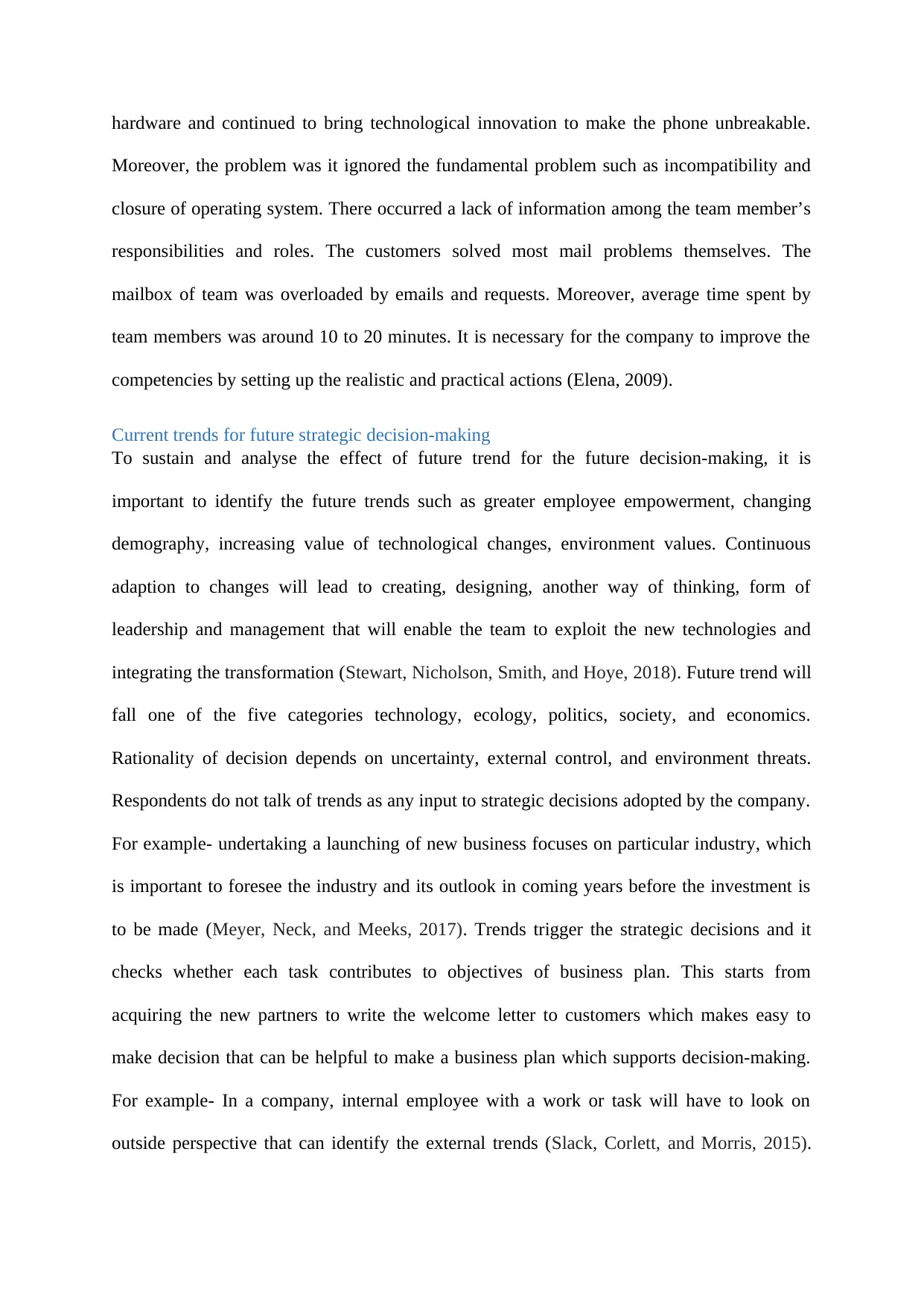
hardware and continued to bring technological innovation to make the phone unbreakable.
Moreover, the problem was it ignored the fundamental problem such as incompatibility and
closure of operating system. There occurred a lack of information among the team member’s
responsibilities and roles. The customers solved most mail problems themselves. The
mailbox of team was overloaded by emails and requests. Moreover, average time spent by
team members was around 10 to 20 minutes. It is necessary for the company to improve the
competencies by setting up the realistic and practical actions (Elena, 2009).
Current trends for future strategic decision-making
To sustain and analyse the effect of future trend for the future decision-making, it is
important to identify the future trends such as greater employee empowerment, changing
demography, increasing value of technological changes, environment values. Continuous
adaption to changes will lead to creating, designing, another way of thinking, form of
leadership and management that will enable the team to exploit the new technologies and
integrating the transformation (Stewart, Nicholson, Smith, and Hoye, 2018). Future trend will
fall one of the five categories technology, ecology, politics, society, and economics.
Rationality of decision depends on uncertainty, external control, and environment threats.
Respondents do not talk of trends as any input to strategic decisions adopted by the company.
For example- undertaking a launching of new business focuses on particular industry, which
is important to foresee the industry and its outlook in coming years before the investment is
to be made (Meyer, Neck, and Meeks, 2017). Trends trigger the strategic decisions and it
checks whether each task contributes to objectives of business plan. This starts from
acquiring the new partners to write the welcome letter to customers which makes easy to
make decision that can be helpful to make a business plan which supports decision-making.
For example- In a company, internal employee with a work or task will have to look on
outside perspective that can identify the external trends (Slack, Corlett, and Morris, 2015).
Moreover, the problem was it ignored the fundamental problem such as incompatibility and
closure of operating system. There occurred a lack of information among the team member’s
responsibilities and roles. The customers solved most mail problems themselves. The
mailbox of team was overloaded by emails and requests. Moreover, average time spent by
team members was around 10 to 20 minutes. It is necessary for the company to improve the
competencies by setting up the realistic and practical actions (Elena, 2009).
Current trends for future strategic decision-making
To sustain and analyse the effect of future trend for the future decision-making, it is
important to identify the future trends such as greater employee empowerment, changing
demography, increasing value of technological changes, environment values. Continuous
adaption to changes will lead to creating, designing, another way of thinking, form of
leadership and management that will enable the team to exploit the new technologies and
integrating the transformation (Stewart, Nicholson, Smith, and Hoye, 2018). Future trend will
fall one of the five categories technology, ecology, politics, society, and economics.
Rationality of decision depends on uncertainty, external control, and environment threats.
Respondents do not talk of trends as any input to strategic decisions adopted by the company.
For example- undertaking a launching of new business focuses on particular industry, which
is important to foresee the industry and its outlook in coming years before the investment is
to be made (Meyer, Neck, and Meeks, 2017). Trends trigger the strategic decisions and it
checks whether each task contributes to objectives of business plan. This starts from
acquiring the new partners to write the welcome letter to customers which makes easy to
make decision that can be helpful to make a business plan which supports decision-making.
For example- In a company, internal employee with a work or task will have to look on
outside perspective that can identify the external trends (Slack, Corlett, and Morris, 2015).
Paraphrase This Document
Need a fresh take? Get an instant paraphrase of this document with our AI Paraphraser
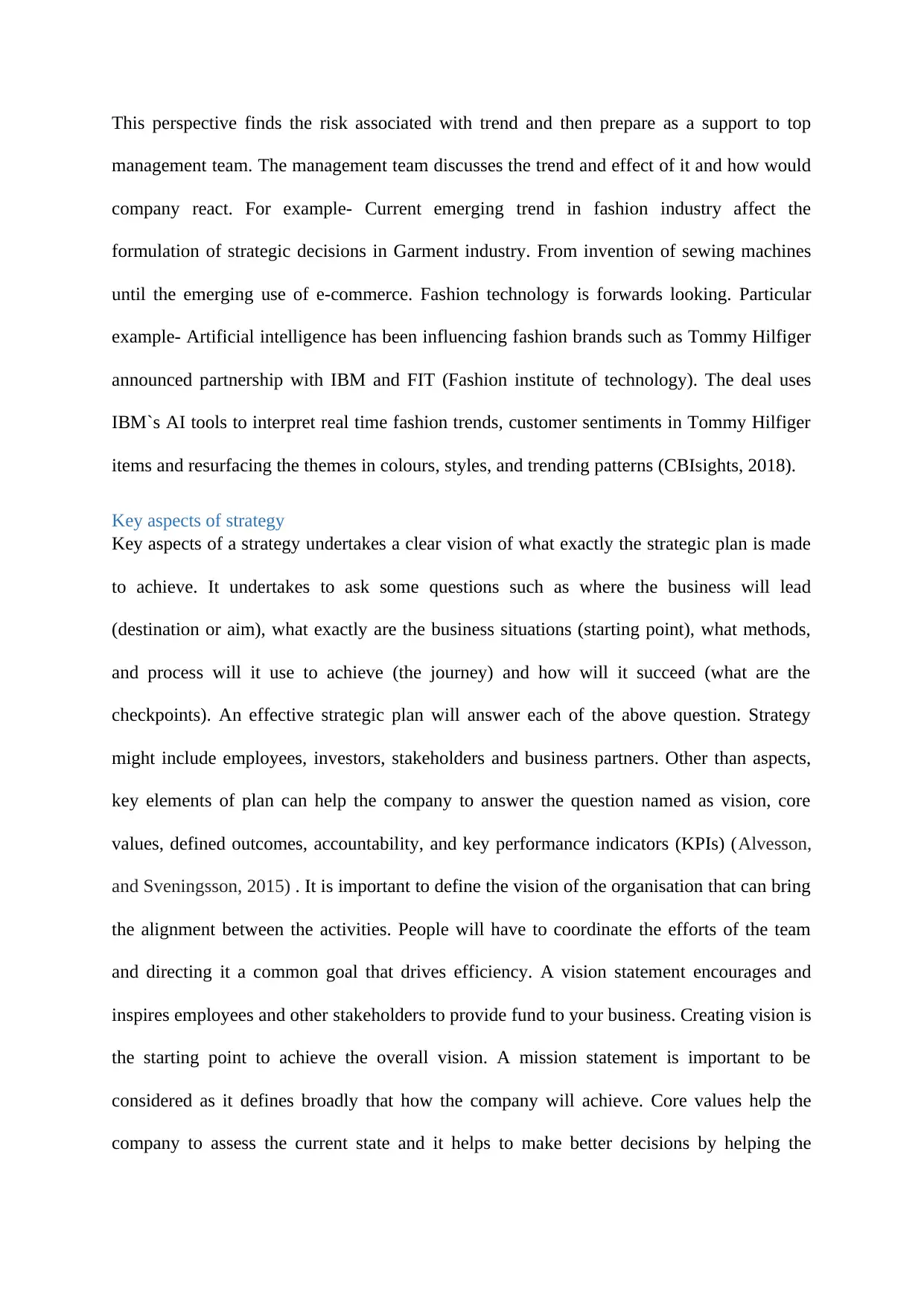
This perspective finds the risk associated with trend and then prepare as a support to top
management team. The management team discusses the trend and effect of it and how would
company react. For example- Current emerging trend in fashion industry affect the
formulation of strategic decisions in Garment industry. From invention of sewing machines
until the emerging use of e-commerce. Fashion technology is forwards looking. Particular
example- Artificial intelligence has been influencing fashion brands such as Tommy Hilfiger
announced partnership with IBM and FIT (Fashion institute of technology). The deal uses
IBM`s AI tools to interpret real time fashion trends, customer sentiments in Tommy Hilfiger
items and resurfacing the themes in colours, styles, and trending patterns (CBIsights, 2018).
Key aspects of strategy
Key aspects of a strategy undertakes a clear vision of what exactly the strategic plan is made
to achieve. It undertakes to ask some questions such as where the business will lead
(destination or aim), what exactly are the business situations (starting point), what methods,
and process will it use to achieve (the journey) and how will it succeed (what are the
checkpoints). An effective strategic plan will answer each of the above question. Strategy
might include employees, investors, stakeholders and business partners. Other than aspects,
key elements of plan can help the company to answer the question named as vision, core
values, defined outcomes, accountability, and key performance indicators (KPIs) (Alvesson,
and Sveningsson, 2015) . It is important to define the vision of the organisation that can bring
the alignment between the activities. People will have to coordinate the efforts of the team
and directing it a common goal that drives efficiency. A vision statement encourages and
inspires employees and other stakeholders to provide fund to your business. Creating vision is
the starting point to achieve the overall vision. A mission statement is important to be
considered as it defines broadly that how the company will achieve. Core values help the
company to assess the current state and it helps to make better decisions by helping the
management team. The management team discusses the trend and effect of it and how would
company react. For example- Current emerging trend in fashion industry affect the
formulation of strategic decisions in Garment industry. From invention of sewing machines
until the emerging use of e-commerce. Fashion technology is forwards looking. Particular
example- Artificial intelligence has been influencing fashion brands such as Tommy Hilfiger
announced partnership with IBM and FIT (Fashion institute of technology). The deal uses
IBM`s AI tools to interpret real time fashion trends, customer sentiments in Tommy Hilfiger
items and resurfacing the themes in colours, styles, and trending patterns (CBIsights, 2018).
Key aspects of strategy
Key aspects of a strategy undertakes a clear vision of what exactly the strategic plan is made
to achieve. It undertakes to ask some questions such as where the business will lead
(destination or aim), what exactly are the business situations (starting point), what methods,
and process will it use to achieve (the journey) and how will it succeed (what are the
checkpoints). An effective strategic plan will answer each of the above question. Strategy
might include employees, investors, stakeholders and business partners. Other than aspects,
key elements of plan can help the company to answer the question named as vision, core
values, defined outcomes, accountability, and key performance indicators (KPIs) (Alvesson,
and Sveningsson, 2015) . It is important to define the vision of the organisation that can bring
the alignment between the activities. People will have to coordinate the efforts of the team
and directing it a common goal that drives efficiency. A vision statement encourages and
inspires employees and other stakeholders to provide fund to your business. Creating vision is
the starting point to achieve the overall vision. A mission statement is important to be
considered as it defines broadly that how the company will achieve. Core values help the
company to assess the current state and it helps to make better decisions by helping the
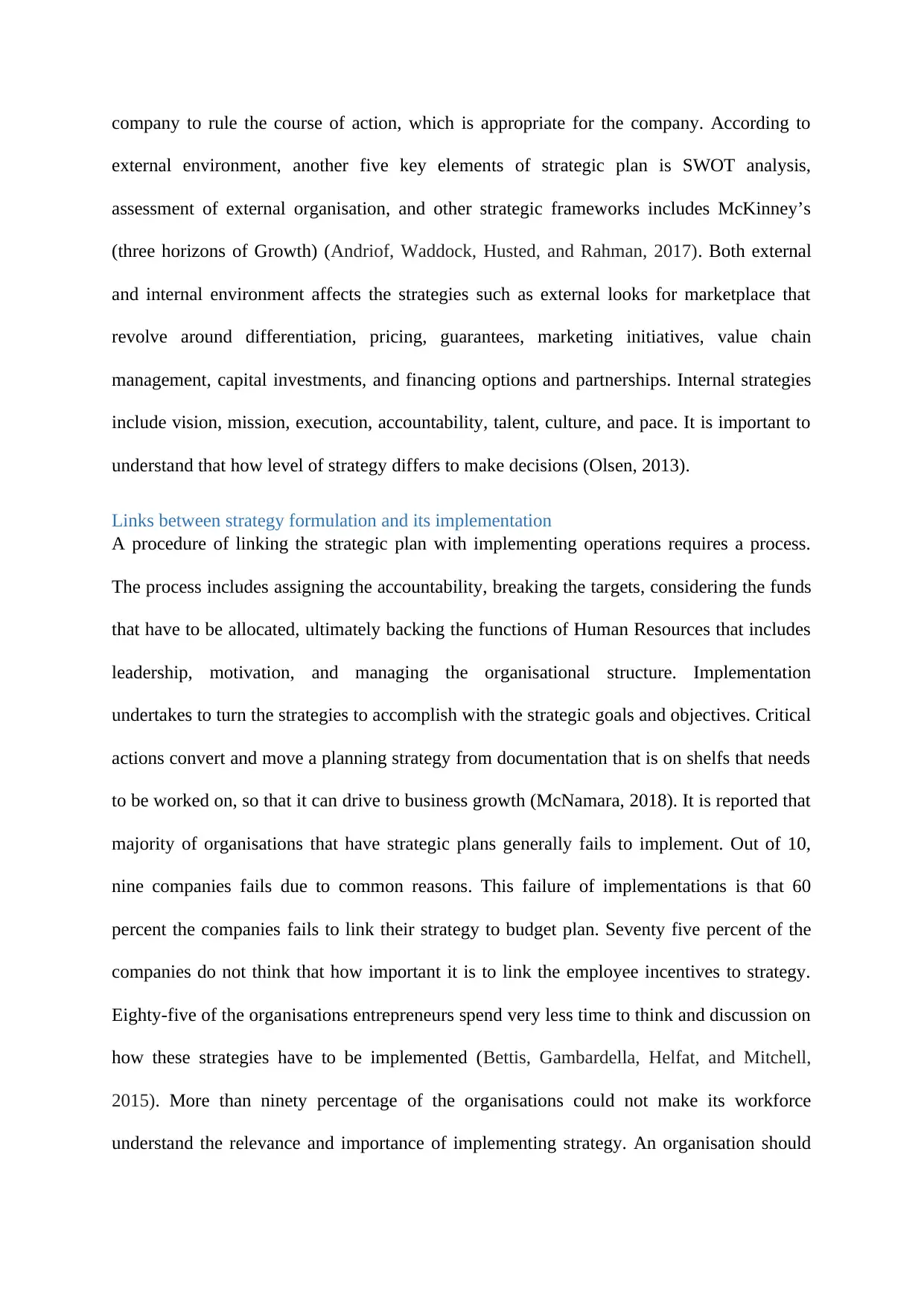
company to rule the course of action, which is appropriate for the company. According to
external environment, another five key elements of strategic plan is SWOT analysis,
assessment of external organisation, and other strategic frameworks includes McKinney’s
(three horizons of Growth) (Andriof, Waddock, Husted, and Rahman, 2017). Both external
and internal environment affects the strategies such as external looks for marketplace that
revolve around differentiation, pricing, guarantees, marketing initiatives, value chain
management, capital investments, and financing options and partnerships. Internal strategies
include vision, mission, execution, accountability, talent, culture, and pace. It is important to
understand that how level of strategy differs to make decisions (Olsen, 2013).
Links between strategy formulation and its implementation
A procedure of linking the strategic plan with implementing operations requires a process.
The process includes assigning the accountability, breaking the targets, considering the funds
that have to be allocated, ultimately backing the functions of Human Resources that includes
leadership, motivation, and managing the organisational structure. Implementation
undertakes to turn the strategies to accomplish with the strategic goals and objectives. Critical
actions convert and move a planning strategy from documentation that is on shelfs that needs
to be worked on, so that it can drive to business growth (McNamara, 2018). It is reported that
majority of organisations that have strategic plans generally fails to implement. Out of 10,
nine companies fails due to common reasons. This failure of implementations is that 60
percent the companies fails to link their strategy to budget plan. Seventy five percent of the
companies do not think that how important it is to link the employee incentives to strategy.
Eighty-five of the organisations entrepreneurs spend very less time to think and discussion on
how these strategies have to be implemented (Bettis, Gambardella, Helfat, and Mitchell,
2015). More than ninety percentage of the organisations could not make its workforce
understand the relevance and importance of implementing strategy. An organisation should
external environment, another five key elements of strategic plan is SWOT analysis,
assessment of external organisation, and other strategic frameworks includes McKinney’s
(three horizons of Growth) (Andriof, Waddock, Husted, and Rahman, 2017). Both external
and internal environment affects the strategies such as external looks for marketplace that
revolve around differentiation, pricing, guarantees, marketing initiatives, value chain
management, capital investments, and financing options and partnerships. Internal strategies
include vision, mission, execution, accountability, talent, culture, and pace. It is important to
understand that how level of strategy differs to make decisions (Olsen, 2013).
Links between strategy formulation and its implementation
A procedure of linking the strategic plan with implementing operations requires a process.
The process includes assigning the accountability, breaking the targets, considering the funds
that have to be allocated, ultimately backing the functions of Human Resources that includes
leadership, motivation, and managing the organisational structure. Implementation
undertakes to turn the strategies to accomplish with the strategic goals and objectives. Critical
actions convert and move a planning strategy from documentation that is on shelfs that needs
to be worked on, so that it can drive to business growth (McNamara, 2018). It is reported that
majority of organisations that have strategic plans generally fails to implement. Out of 10,
nine companies fails due to common reasons. This failure of implementations is that 60
percent the companies fails to link their strategy to budget plan. Seventy five percent of the
companies do not think that how important it is to link the employee incentives to strategy.
Eighty-five of the organisations entrepreneurs spend very less time to think and discussion on
how these strategies have to be implemented (Bettis, Gambardella, Helfat, and Mitchell,
2015). More than ninety percentage of the organisations could not make its workforce
understand the relevance and importance of implementing strategy. An organisation should
⊘ This is a preview!⊘
Do you want full access?
Subscribe today to unlock all pages.

Trusted by 1+ million students worldwide
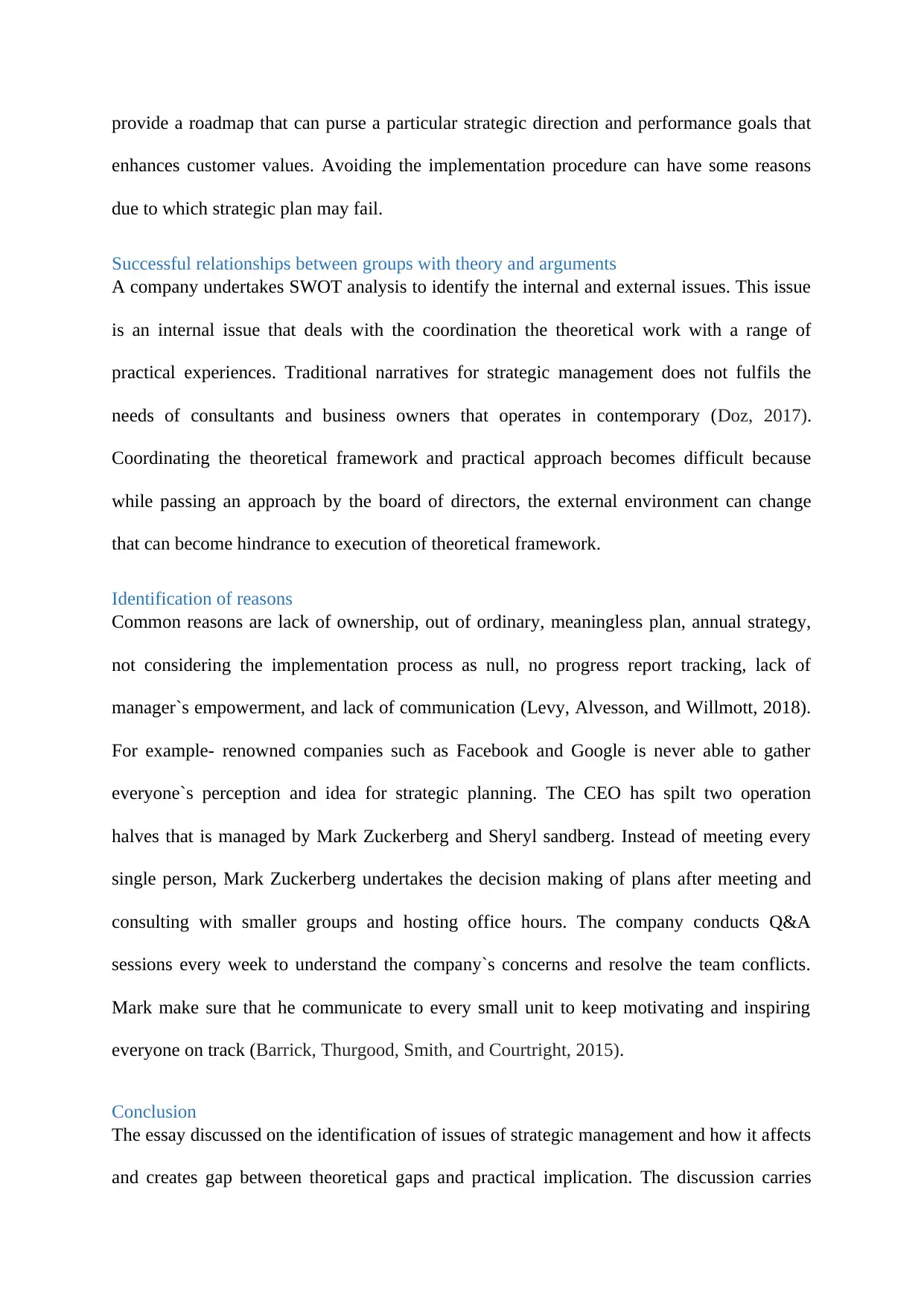
provide a roadmap that can purse a particular strategic direction and performance goals that
enhances customer values. Avoiding the implementation procedure can have some reasons
due to which strategic plan may fail.
Successful relationships between groups with theory and arguments
A company undertakes SWOT analysis to identify the internal and external issues. This issue
is an internal issue that deals with the coordination the theoretical work with a range of
practical experiences. Traditional narratives for strategic management does not fulfils the
needs of consultants and business owners that operates in contemporary (Doz, 2017).
Coordinating the theoretical framework and practical approach becomes difficult because
while passing an approach by the board of directors, the external environment can change
that can become hindrance to execution of theoretical framework.
Identification of reasons
Common reasons are lack of ownership, out of ordinary, meaningless plan, annual strategy,
not considering the implementation process as null, no progress report tracking, lack of
manager`s empowerment, and lack of communication (Levy, Alvesson, and Willmott, 2018).
For example- renowned companies such as Facebook and Google is never able to gather
everyone`s perception and idea for strategic planning. The CEO has spilt two operation
halves that is managed by Mark Zuckerberg and Sheryl sandberg. Instead of meeting every
single person, Mark Zuckerberg undertakes the decision making of plans after meeting and
consulting with smaller groups and hosting office hours. The company conducts Q&A
sessions every week to understand the company`s concerns and resolve the team conflicts.
Mark make sure that he communicate to every small unit to keep motivating and inspiring
everyone on track (Barrick, Thurgood, Smith, and Courtright, 2015).
Conclusion
The essay discussed on the identification of issues of strategic management and how it affects
and creates gap between theoretical gaps and practical implication. The discussion carries
enhances customer values. Avoiding the implementation procedure can have some reasons
due to which strategic plan may fail.
Successful relationships between groups with theory and arguments
A company undertakes SWOT analysis to identify the internal and external issues. This issue
is an internal issue that deals with the coordination the theoretical work with a range of
practical experiences. Traditional narratives for strategic management does not fulfils the
needs of consultants and business owners that operates in contemporary (Doz, 2017).
Coordinating the theoretical framework and practical approach becomes difficult because
while passing an approach by the board of directors, the external environment can change
that can become hindrance to execution of theoretical framework.
Identification of reasons
Common reasons are lack of ownership, out of ordinary, meaningless plan, annual strategy,
not considering the implementation process as null, no progress report tracking, lack of
manager`s empowerment, and lack of communication (Levy, Alvesson, and Willmott, 2018).
For example- renowned companies such as Facebook and Google is never able to gather
everyone`s perception and idea for strategic planning. The CEO has spilt two operation
halves that is managed by Mark Zuckerberg and Sheryl sandberg. Instead of meeting every
single person, Mark Zuckerberg undertakes the decision making of plans after meeting and
consulting with smaller groups and hosting office hours. The company conducts Q&A
sessions every week to understand the company`s concerns and resolve the team conflicts.
Mark make sure that he communicate to every small unit to keep motivating and inspiring
everyone on track (Barrick, Thurgood, Smith, and Courtright, 2015).
Conclusion
The essay discussed on the identification of issues of strategic management and how it affects
and creates gap between theoretical gaps and practical implication. The discussion carries
Paraphrase This Document
Need a fresh take? Get an instant paraphrase of this document with our AI Paraphraser

relevant business examples of the companies that could not accomplish to their theoretical
knowledge. The essay also discusses on how external environment affects and changes the
strategic planning, an illustration of tommy Hilfiger portrays that how it collaborated with
IBM for artificial intelligence.
knowledge. The essay also discusses on how external environment affects and changes the
strategic planning, an illustration of tommy Hilfiger portrays that how it collaborated with
IBM for artificial intelligence.
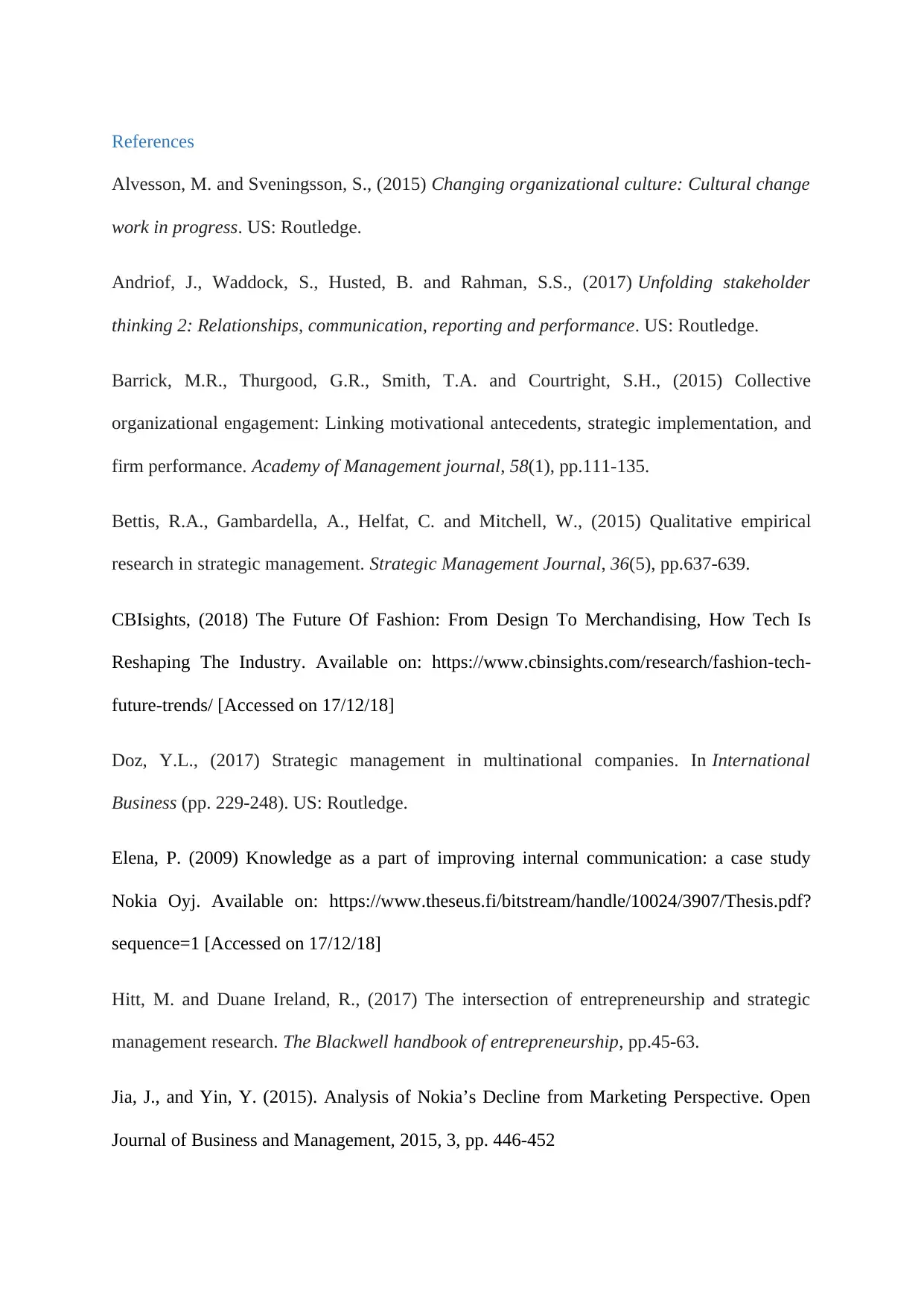
References
Alvesson, M. and Sveningsson, S., (2015) Changing organizational culture: Cultural change
work in progress. US: Routledge.
Andriof, J., Waddock, S., Husted, B. and Rahman, S.S., (2017) Unfolding stakeholder
thinking 2: Relationships, communication, reporting and performance. US: Routledge.
Barrick, M.R., Thurgood, G.R., Smith, T.A. and Courtright, S.H., (2015) Collective
organizational engagement: Linking motivational antecedents, strategic implementation, and
firm performance. Academy of Management journal, 58(1), pp.111-135.
Bettis, R.A., Gambardella, A., Helfat, C. and Mitchell, W., (2015) Qualitative empirical
research in strategic management. Strategic Management Journal, 36(5), pp.637-639.
CBIsights, (2018) The Future Of Fashion: From Design To Merchandising, How Tech Is
Reshaping The Industry. Available on: https://www.cbinsights.com/research/fashion-tech-
future-trends/ [Accessed on 17/12/18]
Doz, Y.L., (2017) Strategic management in multinational companies. In International
Business (pp. 229-248). US: Routledge.
Elena, P. (2009) Knowledge as a part of improving internal communication: a case study
Nokia Oyj. Available on: https://www.theseus.fi/bitstream/handle/10024/3907/Thesis.pdf?
sequence=1 [Accessed on 17/12/18]
Hitt, M. and Duane Ireland, R., (2017) The intersection of entrepreneurship and strategic
management research. The Blackwell handbook of entrepreneurship, pp.45-63.
Jia, J., and Yin, Y. (2015). Analysis of Nokia’s Decline from Marketing Perspective. Open
Journal of Business and Management, 2015, 3, pp. 446-452
Alvesson, M. and Sveningsson, S., (2015) Changing organizational culture: Cultural change
work in progress. US: Routledge.
Andriof, J., Waddock, S., Husted, B. and Rahman, S.S., (2017) Unfolding stakeholder
thinking 2: Relationships, communication, reporting and performance. US: Routledge.
Barrick, M.R., Thurgood, G.R., Smith, T.A. and Courtright, S.H., (2015) Collective
organizational engagement: Linking motivational antecedents, strategic implementation, and
firm performance. Academy of Management journal, 58(1), pp.111-135.
Bettis, R.A., Gambardella, A., Helfat, C. and Mitchell, W., (2015) Qualitative empirical
research in strategic management. Strategic Management Journal, 36(5), pp.637-639.
CBIsights, (2018) The Future Of Fashion: From Design To Merchandising, How Tech Is
Reshaping The Industry. Available on: https://www.cbinsights.com/research/fashion-tech-
future-trends/ [Accessed on 17/12/18]
Doz, Y.L., (2017) Strategic management in multinational companies. In International
Business (pp. 229-248). US: Routledge.
Elena, P. (2009) Knowledge as a part of improving internal communication: a case study
Nokia Oyj. Available on: https://www.theseus.fi/bitstream/handle/10024/3907/Thesis.pdf?
sequence=1 [Accessed on 17/12/18]
Hitt, M. and Duane Ireland, R., (2017) The intersection of entrepreneurship and strategic
management research. The Blackwell handbook of entrepreneurship, pp.45-63.
Jia, J., and Yin, Y. (2015). Analysis of Nokia’s Decline from Marketing Perspective. Open
Journal of Business and Management, 2015, 3, pp. 446-452
⊘ This is a preview!⊘
Do you want full access?
Subscribe today to unlock all pages.

Trusted by 1+ million students worldwide
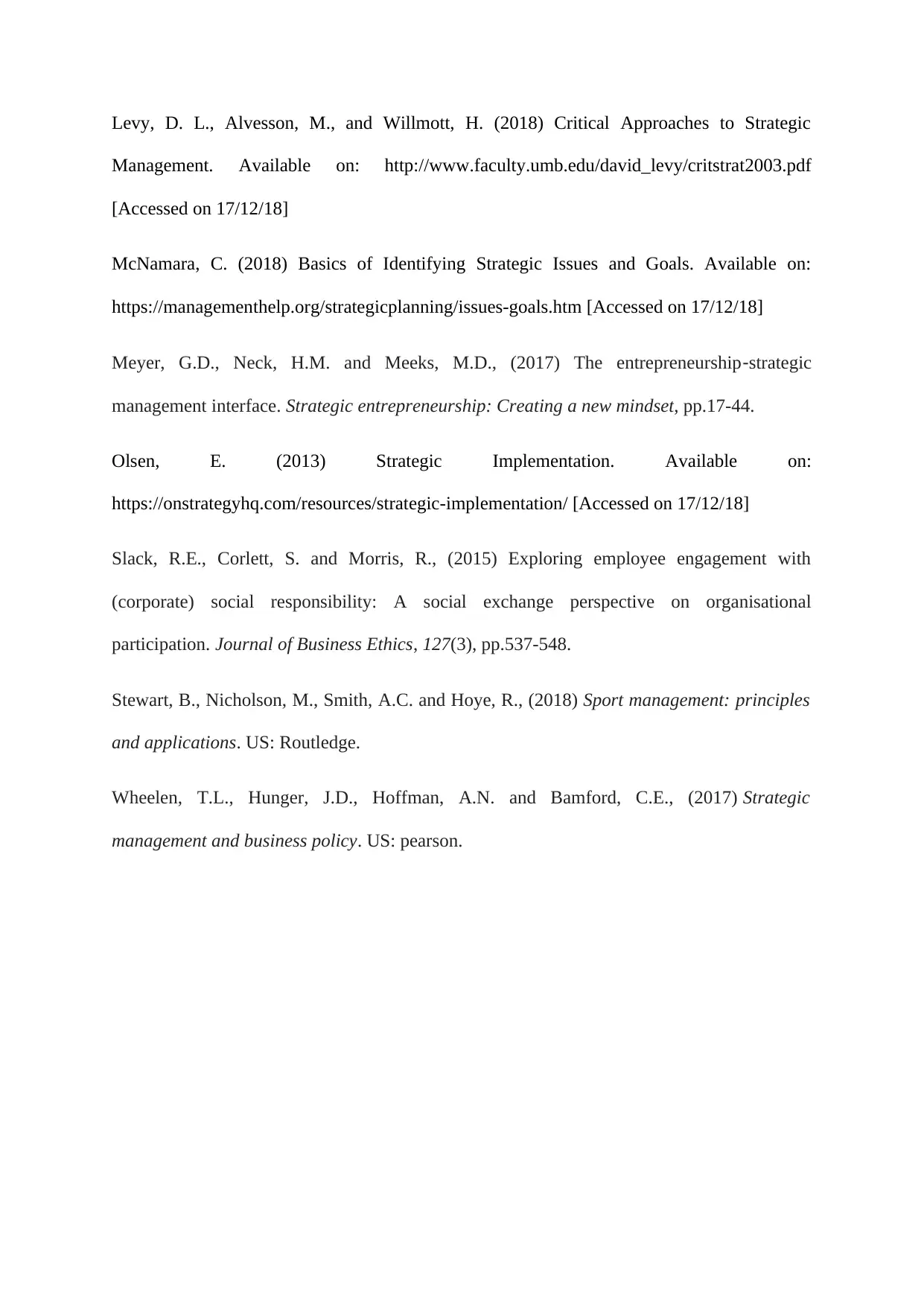
Levy, D. L., Alvesson, M., and Willmott, H. (2018) Critical Approaches to Strategic
Management. Available on: http://www.faculty.umb.edu/david_levy/critstrat2003.pdf
[Accessed on 17/12/18]
McNamara, C. (2018) Basics of Identifying Strategic Issues and Goals. Available on:
https://managementhelp.org/strategicplanning/issues-goals.htm [Accessed on 17/12/18]
Meyer, G.D., Neck, H.M. and Meeks, M.D., (2017) The entrepreneurship‐strategic
management interface. Strategic entrepreneurship: Creating a new mindset, pp.17-44.
Olsen, E. (2013) Strategic Implementation. Available on:
https://onstrategyhq.com/resources/strategic-implementation/ [Accessed on 17/12/18]
Slack, R.E., Corlett, S. and Morris, R., (2015) Exploring employee engagement with
(corporate) social responsibility: A social exchange perspective on organisational
participation. Journal of Business Ethics, 127(3), pp.537-548.
Stewart, B., Nicholson, M., Smith, A.C. and Hoye, R., (2018) Sport management: principles
and applications. US: Routledge.
Wheelen, T.L., Hunger, J.D., Hoffman, A.N. and Bamford, C.E., (2017) Strategic
management and business policy. US: pearson.
Management. Available on: http://www.faculty.umb.edu/david_levy/critstrat2003.pdf
[Accessed on 17/12/18]
McNamara, C. (2018) Basics of Identifying Strategic Issues and Goals. Available on:
https://managementhelp.org/strategicplanning/issues-goals.htm [Accessed on 17/12/18]
Meyer, G.D., Neck, H.M. and Meeks, M.D., (2017) The entrepreneurship‐strategic
management interface. Strategic entrepreneurship: Creating a new mindset, pp.17-44.
Olsen, E. (2013) Strategic Implementation. Available on:
https://onstrategyhq.com/resources/strategic-implementation/ [Accessed on 17/12/18]
Slack, R.E., Corlett, S. and Morris, R., (2015) Exploring employee engagement with
(corporate) social responsibility: A social exchange perspective on organisational
participation. Journal of Business Ethics, 127(3), pp.537-548.
Stewart, B., Nicholson, M., Smith, A.C. and Hoye, R., (2018) Sport management: principles
and applications. US: Routledge.
Wheelen, T.L., Hunger, J.D., Hoffman, A.N. and Bamford, C.E., (2017) Strategic
management and business policy. US: pearson.
1 out of 10
Related Documents
Your All-in-One AI-Powered Toolkit for Academic Success.
+13062052269
info@desklib.com
Available 24*7 on WhatsApp / Email
![[object Object]](/_next/static/media/star-bottom.7253800d.svg)
Unlock your academic potential
Copyright © 2020–2025 A2Z Services. All Rights Reserved. Developed and managed by ZUCOL.





